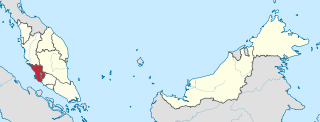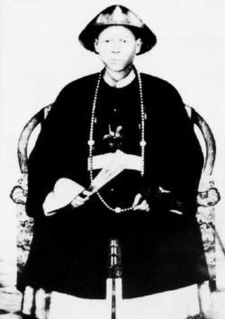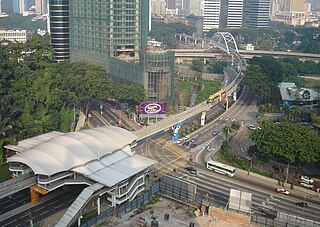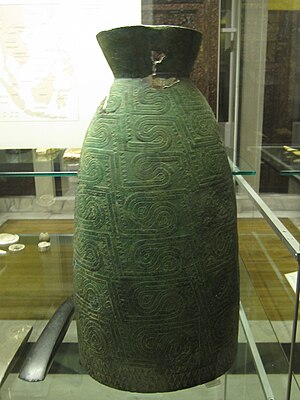
Kuala Lumpur, officially the Federal Territory of Kuala Lumpur and colloquially referred to as KL, is a federal territory and the ceremonial, legislative and judicial capital city of Malaysia. It is one of the fastest growing cities in Asia and the largest city in Malaysia, covering an area of 243 km2 (94 sq mi) with a census population of 1,982,112 as of 2020. Greater Kuala Lumpur, also known as the Klang Valley, is an urban agglomeration of 7.564 million people as of 2018. It is among the fastest growing metropolitan regions in Southeast Asia, both in population and economic development.

Selangor, also known by its Arabic honorific Darul Ehsan, or "Abode of Sincerity", is one of the 13 Malaysian states. It is on the west coast of Peninsular Malaysia and is bordered by Perak to the north, Pahang to the east, Negeri Sembilan to the south, and the Strait of Malacca to the west. Selangor surrounds the federal territories of Kuala Lumpur and Putrajaya, both of which were previously part of it. Selangor has diverse tropical rainforests and an equatorial climate. The state's mountain ranges belong to the Titiwangsa Mountains, which is part of the Tenasserim Hills that covers southern Myanmar, southern Thailand and Peninsular Malaysia, with Mount Semangkok as the highest point in the state.

Klang or Kelang, officially Royal City of Klang, is a royal city and former capital of the state of Selangor, Malaysia. It is located within the Klang District. It was the civil capital of Selangor in an earlier era prior to the emergence of Kuala Lumpur and the current capital, Shah Alam. Port Klang, which is located in the Klang District, is the 12th busiest transshipment port and the 12th busiest container port in the world.

Sir Frank Athelstane Swettenham was a British colonial administrator who became the first Resident general of the Federated Malay States, which brought the Malay states of Selangor, Perak, Negeri Sembilan and Pahang together under the administration of a Resident-General based in Kuala Lumpur. He served from 1 July 1896 to 4 November 1901. He was also an amateur painter, photographer and antique collector.

Kapitan China Yap Ah Loy, also known as Yap Tet Loy and Yap Mao Lan, is an important figure of early Kuala Lumpur. He served as the third Kapitan China of Kuala Lumpur, and in this administrative capacity, played an important role in developing the city as a commercial and mining centre during the 19th century.

The Sultan Abdul Samad Building is a late-nineteenth century building located along Jalan Raja in front of the Dataran Merdeka and the Royal Selangor Club in Kuala Lumpur, Malaysia. The building originally housed the offices of the British colonial administration, and was known simply as Government Offices in its early years. In 1974, it was renamed after Sultan Abdul Samad, the reigning sultan of Selangor at the time when construction began.

Independence Square is a square located in Kuala Lumpur, Malaysia. It is situated in front of the Sultan Abdul Samad Building. It was formerly known as the Selangor Club Padang or simply the Padang and was used as the cricket green of the Selangor Club. It was here that the Union Flag was lowered and the Malaysian flag hoisted for the first time at midnight on 31 August 1957. Since then, the Independence Square has been the usual venue for the annual Independence Day Parade.

Ampang, or Ampang Hilir, is a ward and city district, in the eastern part of Kuala Lumpur (KL) in the Titiwangsa constituency. Its area in Kuala Lumpur can be identified as being along the Ampang Road and Ampang Hilir.

Bukit Nanas, meaning "Pineapple Hill", is a small hill in Kuala Lumpur, Malaysia. With a height of 94 meter above sea level, it contains the only virgin tropical rain forest left in the heart of Kuala Lumpur. The Bukit Nanas Forest Reserve is located here, and is open to the public. There are jungle trails, a visitors centre, and a forestry museum.

Ampang Jaya, more commonly known as just Ampang, is a town, a mukim and a parliamentary constituency straddling parts of the Hulu Langat District and Gombak District, in eastern Selangor, Malaysia. It is located just outside the eastern border of Kuala Lumpur Federal Territory.

Kuala Lumpur is the largest city in Malaysia; it is also the nation's capital. The history of Kuala Lumpur began in the middle of the 19th century with the rise of the tin mining industry, and boomed in the early 20th century with the development of rubber plantations in Selangor. It became the capital of Selangor, later the Federated Malay States, and then Malayan Union, and finally Malaya and Malaysia.

Jalan Damansara is a major road in Kuala Lumpur, Malaysia. One of the oldest roads in the city, it currently serves as a link between the Damansara sections of Petaling Jaya and Kuala Lumpur.
Damansara is a suburb in Petaling Jaya, a mukim in Petaling District, as well as a parliamentary constituency in Selangor, Malaysia. It is named after the Damansara River which flows nearby. It is one of the most densely populated areas in Malaysia. According to the 2000 Census of Malaysia, it was the second-largest district subdivision in Malaysia in terms of population with 453,420 residents.
Kapitan China Yap Ah Shak of Petaling served as the fourth and penultimate Kapitan China of nineteenth-century Kuala Lumpur. He was a wealthy Huizhou Hakka merchant and a Hai San leader.

The Kinta Valley is a conurbation in central Perak, Malaysia, surrounding and including the state capital Ipoh. Historically the Kinta Valley was very rich in tin, and their mines have been among the most productive in the world. The valley is formed by the Kinta River, a tributary of the Perak River, which flows between the Titiwangsa Mountains and the Kledang Range.

Malaysian Indians or Indian Malaysians are Malaysian citizens of Indian or South Asian ancestry. They now form the third-largest group in Malaysia, after the Malays and the Chinese. Most are descendants of those who migrated from India to British Malaya from the early 19th to the mid-20th centuries.
The Malaysian Branch of the Royal Asiatic Society (MBRAS) is a learned society based in Kuala Lumpur, Malaysia.
John Michael Gullick was a British Orientalist who is chiefly remembered for his ground-breaking contributions to the study of pre-colonial and early colonial Malay society, Indigenous Political Systems of Western Malaya (1958), Malay Society in the Late Nineteenth Century: The Beginnings of Change (1987) and Rulers and Residents: Influence and Power in the Malay States 1870–1920 (1992).
















